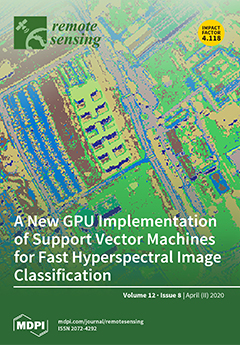On the morning of 24 December 2018, an eruptive event occurred at Etna, which was followed the next day by a strong sequence of shallow earthquakes. The eruptive episode lasted until 30 December, ranging from moderate strombolian to lava fountain activity coupled with
[...] Read more.
On the morning of 24 December 2018, an eruptive event occurred at Etna, which was followed the next day by a strong sequence of shallow earthquakes. The eruptive episode lasted until 30 December, ranging from moderate strombolian to lava fountain activity coupled with vigorous ash/gas emissions and a lava flow effusion toward the eastern volcano flank of Valle del Bove. In this work, the data collected from the Spinning Enhanced Visible and InfraRed Imager (SEVIRI) instruments on board the Meteosat Second Generation (MSG) geostationary satellite are used to characterize the Etna activity by estimating the proximal and distal eruption parameters in near real time. The inversion of data indicates the onset of eruption on 24 December at 11:15 UTC, a maximum Time Average Discharge Rate (TADR) of 8.3 m
3/s, a cumulative lava volume emitted of 0.5 Mm
3, and a Volcanic Plume Top Height (VPTH) that reached a maximum altitude of 8 km above sea level (asl). The volcanic cloud ash and SO
2 result totally collocated, with an ash amount generally lower than SO
2 except on 24 December during the climax phase. A total amount of about 100 and 35 kt of SO
2 and ash respectively was emitted during the entire eruptive period, while the SO
2 fluxes reached peaks of more than 600 kg/s, with a mean value of about 185 kg/s. The SEVIRI VPTH, ash/SO
2 masses, and flux time series have been compared with the results obtained from the ground-based visible (VIS) cameras and FLux Automatic MEasurements (FLAME) networks, and the satellite images collected by the MODerate resolution Imaging Spectroradiometer (MODIS) instruments on board the Terra and Aqua- polar satellites. The analysis indicates good agreement between SEVIRI, VIS camera, and MODIS retrievals with VPTH, ash, and SO
2 estimations all within measurement errors. The SEVIRI and FLAME SO
2 flux retrievals show significant discrepancies due to the presence of volcanic ash and a gap of data on the FLAME network. The results obtained in this study show the ability of geostationary satellite systems to characterize eruptive events from the source to the atmosphere in near real time during the day and night, thus offering a powerful tool to mitigate volcanic risk on both local population and airspace and to give insight on volcanic processes.
Full article





